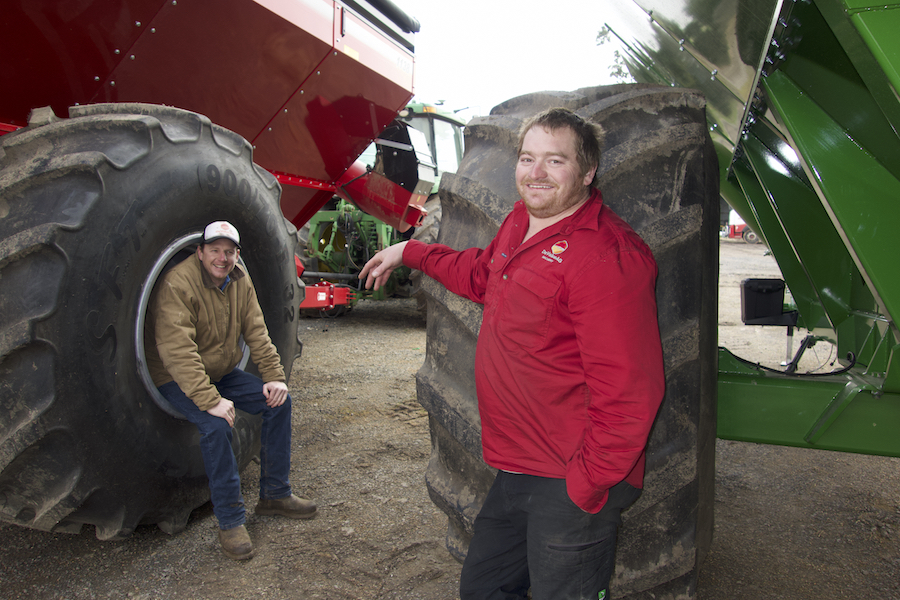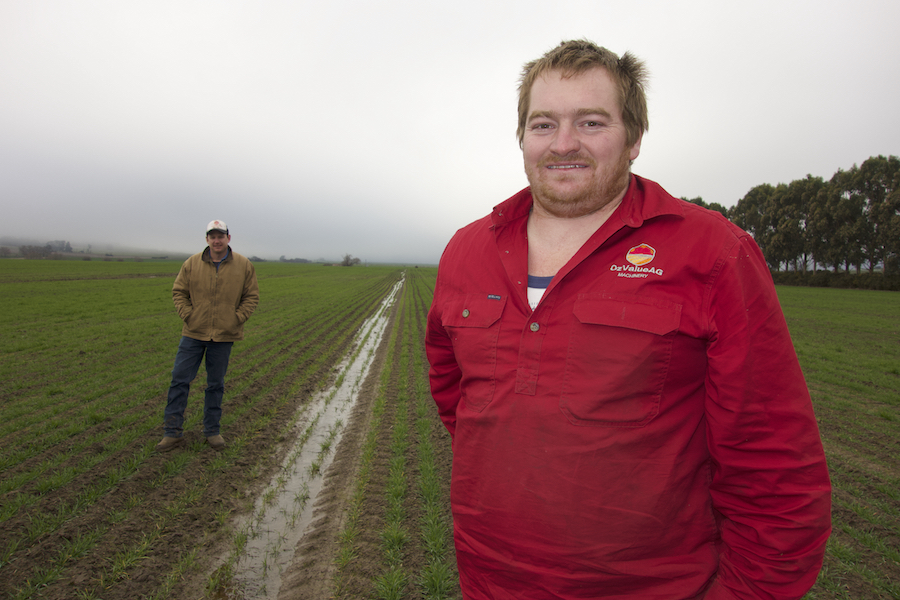Agronomic finesse underpins winning crop
Sixth-generation Weatherboard grower Ben Findlay produced an award-winning wheat crop, pushing above 10 tonnes per hectare, on his family’s farm near Ballarat, Victoria. Photo: Clarisa Collis
In most years, snow settles on the shoulders of an extinct volcano that dominates the landscape where six generations of the Findlay family have farmed their ‘Heathfield’ property in the Weatherboard district near Ballarat in south-western Victoria.
In this place of climatic extremes – prone to waterlogging, sub-zero temperatures, low solar radiation and high winds, as well as snow – Ben Findlay, with farm operations manager Chris Karslake, has produced an award-winning wheat crop.
Ben received the ‘southern Victoria highest yield’ award for growing a 31ha paddock of the RGT Accroc wheat variety that yielded 10.4 tonnes/ha during the 2020 season.
It was the top-yielding crop in Victoria, and placed third nationally for yield, in the first year of the Hyper Yielding Crops (HYC) awards, presented as part of the GRDC-invested HYC project from 2020–24 led by Field Applied Research (FAR) Australia.
Ben was one of three Victorian winners (covering southern and northern categories) and nine Australia-wide winners. These winners were selected from a field of 65 growers across the country who entered wheat paddocks in 2020 and volunteered data for each paddock in the HYC awards.
HYC national extension coordinator Jon Midwood from TechCrop Services says the awards program aims to evaluate the performance of growers’ wheat paddocks and identify agronomic practices that can hyperdrive yield.
Ben says the award-winning wheat, pushing above 10t/ha, was achieved with a mix of variety selection and new agronomic practices implemented in the past four years.
Some of these tactics were drawn from another Tasmania-based, GRDC-invested project that concluded in 2019. This preceding five-year research effort – the Hyper Yielding Cereals project – was also led by FAR Australia, in collaboration with Southern Farming Systems, from 2015.
The project, and other trials on the mainland, showed hyper-yielding cereal varieties and agronomic strategies could be adapted to cropping areas across the country’s other high-rainfall growing areas.
“The project results helped show what was achievable with the right variety grown in the appropriate environment with optimal agronomic management,” Mr Midwood says.
“The Hyper Yielding Cereals project generated enormous attention from mainland growers,” says Nick Poole, FAR Australia managing director and leader of both HYC projects.

Sixth-generation weatherboard grower ben findlay (right) and farm operations manager chris karslake produced victoria’s top-yielding wheat crop in the 2020 hyper yielding crops awards. Photo: clarisa collis
Hyper-yielding variety
Among the mainland growers following its research findings were Ben and Chris, who switched to growing the RGT Accroc winter wheat variety in 2019 because of the earlier HYC project that set new yield benchmarks for cereal cropping in Tasmania.
RGT Accroc was one of four high-performance wheat lines identified by FAR Australia researchers to underpin the new yield benchmark of 13 to 13.5t/ha for Tasmanian feed wheat. And highlighting its widespread adoption, about 36 per cent of Victorian growers who nominated paddocks for the 2020 HYC awards opted to grow RGT Accroc.
This cultivar, as well as RGT Relay, RGT Calabro and Annapurna, were shortlisted as hyper-yielding wheat varieties based on four main attributes: high yield, straw strength (to reduce lodging in heavy high-yielding crops), disease resistance and plant development (phenology) suited to April sowing in Tasmania.
Prior to its adoption, Ben and Chris road-tested the on-farm performance of RGT Accroc in paddock strip trials. The paddock testing is part of a program for varietal renewal that sees cultivars replaced with a higher-yielding alternative on the ‘Heathfield’ farm every three or four years.
Fungicide strategy
Also contributing to the award win was a fine-tuned approach to fungicide application gleaned from the Tasmanian HYC project, which developed agronomic strategies to secure the yield potential of high-performance cultivars such as RGT Accroc.
For instance, when growing the 10.4t/ha wheat crop last year, Ben and Chris added a new late-season fungicide application to their disease management regime, targeting high pressure from Septoria tritici blotch, as well as stripe and leaf rusts.
The Group 3 fungicide product, Tebuconazole 430 SC, containing the active ingredient tebuconazole, was applied to RGT Accroc wheat on 14 October at a rate of 290 millimetres/ha at growth stage (GS) 59 (head emergence).
“Until last season, we hadn’t applied fungicide that late in the crop’s development,” Ben says. “Visual assessment of the crop suggested it did make a difference to yield because there were a lot fewer dead grain heads in the 2020 crop compared with previous years.
“And the additional spray has returned more profit through yield gain than the $10/ha it costs to apply.”
Trials in 2018 and 2019 of the HYC project showed the return on fungicide investment for the hyper-yielding winter wheat lines was typically $3 to $4 for every dollar spent.
In addition to the new ‘head wash’ fungicide spray at GS59, Ben and Chris also applied fungicide to the award-winning wheat at three other growth stages: GS31 (first node), GS32 (second node) and GS39 (flag leaf emergence).
As such, their approach to disease control, particularly the timing of fungicide applications, was closely aligned with the fungicide strategy for wheat developed through the Tasmanian HYC project.
In this strategy, the timing of fungicide applications is crucial for optimising the productivity and profitability of hyper-yielding wheat by controlling disease on the main leaves that contribute to yield, Mr Midwood says.
The HYC disease-control strategy for hyper-yielding wheat in Tasmania comprises three fungicide applications at GS31, GS39 and GS59.

Ben findlay (right) and chris karslake in a wheat paddock prone to waterlogging, sub-zero temperatures and low solar radiation on the heathfield farm at weatherboard, victoria, this growing season. Photo: clarisa collis
Earlier sowing
Ben says earlier sowing is another significant practice change that contributed to the award-winning crop.
Wheat was traditionally sown on the ‘Heathfield’ farm in late April, but now it is sown in early April. For instance, the HYC wheat paddock was planted on 9 April last year, using a seeding rate of 110 kilograms/ha on 25-centimetre row spacings.
“Our wheat sowing date has gradually been brought forward by about five days a year over the past four years,” Ben says
“Sowing the crop nearly a month earlier provides a wheat yield advantage of up to 4t/ha.
“This yield gain has, in part, been achieved by growing the RGT Accroc winter wheat variety with a vernalisation (cold) requirement.”
He says sowing wheat in early April leads to improved crop establishment when soil temperatures are warmer and a longer growing season conducive to higher yields. Early sowing wheat also improves the flexibility and efficiency of cropping operations because there is more opportunity for spraying to control weeds, diseases and insect pests in favourable weather conditions during mid-autumn.
Yield potential
All growers participating in the HYC awards were provided with a detailed report that allows them to evaluate their agronomic approach compared with other growers nationally, but particularly in the same cropping region.
For Ben, data contained in the report has also enabled him to benchmark the agronomic performance of his wheat against the aspirational or biophysical potential yield that could be achieved on the family farm.
For instance, the HYC data showed the Findlays’ wheat achieved about 94 per cent of its yield potential, estimated at 11.02t/ha.
This result saw Ben place fourth nationally, based on a national ranking for the percentage of yield potential achieved by participating growers. The HYC team developed the yield potential estimates for each wheat crop using a model incorporating paddock-specific conditions, such as rainfall, soil water-holding capacity, temperature and solar radiation.
More information: Ben Findlay, 0439 448 999, ben@ozvalueag.com.au; Jon Midwood, 0400 666 434, jon@techcrop.com.au
Source: GRDC Groundcover